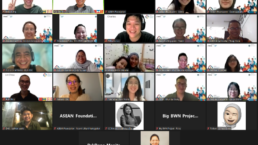Important aspects of a social enterprise business are product scalability and a resilient supply chain to enable the business to grow effectively. Online training sessions #5 and #6 of ASEAN SEDP 2.0 delved deeper into strategies for product scalability and understanding supply chain strategies for social enterprises. Session 5, entitled “Expanding Horizons: Strategies for Product Scalability in Social Enterprises,” with Michael Ong, Product Team Coach at the Collab Folks, took place on 14 Sep 2023.
In this session, Michael Ong introduces us to product personalisation and scalability. “With the customisation of products or services, we meet customer needs. On the other hand, scalability meets business growth. Striking the right balance is key to a successful social enterprise,” said Michael Ong.
“For a social enterprise, the choice between customisation and mass production often depends on its mission, target audience, operational capabilities, and market demand. It’s also possible for social enterprises to adopt a hybrid approach, offering some customised products while mass-producing others,” said Michael.
Both customised products and mass-produced items have their advantages and disadvantages. The advantages of unique, customised products include a higher value proposition, customer loyalty, flexibility, and differentiation. However, the disadvantages are higher production costs, scalability issues, inconsistency, and longer lead times. On the other hand, identical, mass-produced items come with advantages such as economies of scale, consistency, faster production, and easier distribution. The disadvantage is the lack of personalisation, competition, inventory risks, and less flexibility.
In session #6 participants of ASEAN SEDP 2.0 learned about supply chain strategies. The session was entitled “Streamlining Supply Chains for Social Enterprises” with Danang Surowilopo, the Supply Chain Practitioner in the Humanitarian and Development Sector, on 15 Sep 2023. .
Gilang quoted the definition of a supply chain, which involves the design, planning, execution, control, and monitoring of supply chain activities (orchestration) to create net value, building a competitive infrastructure, leveraging worldwide logistics, synchronising supply with demand, and measuring performance globally. Ultimately, this supply chain fulfils customer requests.
“The supply chain involves various actors, including suppliers, manufacturers, distributors, retailers, consumers, and transporters. This supply chain also encompasses the flow of products or materials, financial transactions, information, value addition, and risk,” said Danang.
He added that there are three types of supply chain strategies. The first is the efficient supply chain strategy, where businesses utilise lean production advantages and economies of scale. They primarily focus on cost reduction through high-capacity utilisation, inventory minimisation, and partnerships with low-cost suppliers. The second is the adaptive and resilient supply chain strategy, which aims to ensure operational continuity and meet demand. This approach involves increasing inventory capacity and collaborating with multiple suppliers and manufacturers. The third strategy is responsive, focusing on demand fulfilment and customer satisfaction. It responds to a wide range of demand quantities, meets short lead times, handles a diverse product range, promotes innovation, and maintains high service levels.
Most of the social enterprises in SEDP 2.0 are primarily of the adaptive and resilient type. One of them is Lukthamdai, a digital assistant platform dedicated to promoting child development based in Thailand. Preeyasorn Arsrairas, the founder of Lukthamdai, mentioned that they are gathering various types of suppliers. In their case, doctors, nurses, or professionals who offer child development monitoring and assessment services are the ones delivering core services.
Beni Pamungkas, the Manager of Operational Business at Komerce, enquired about whether customer service is part of logistics and the supply chain. He wondered how customer service is related to the supply chain. Komerce is a social enterprise aiming to address challenges faced by rural youths in finding employment in their hometowns, which often forces them to migrate to larger cities. Komerce also connects them with Small Medium Enterprises (SMEs) to assist with their business operations.
In response to the question, Danang explained that every return, complaint, and refund from customers is handled in the customer service area. The customer service team can respond appropriately and then forward the complaint to the logistics unit or warehouse. Therefore, a customer’s complaint can trigger continuous improvement in the company. Customer service is not just a single unit but also a mindset for all staff involved in the supply chain.
In the end, the concept of the supply chain applies to anyone, not only in the goods industry but also in the service industry. They also perform mapping the actors, understanding the processes, and mapping the demand and internal capacity. The fundamental concept of the supply chain is to meet customer demand throughout the processes. If necessary, resources can be outsourced, or in the case of social enterprise providing applications, they can be adapted to accommodate customer demands.


